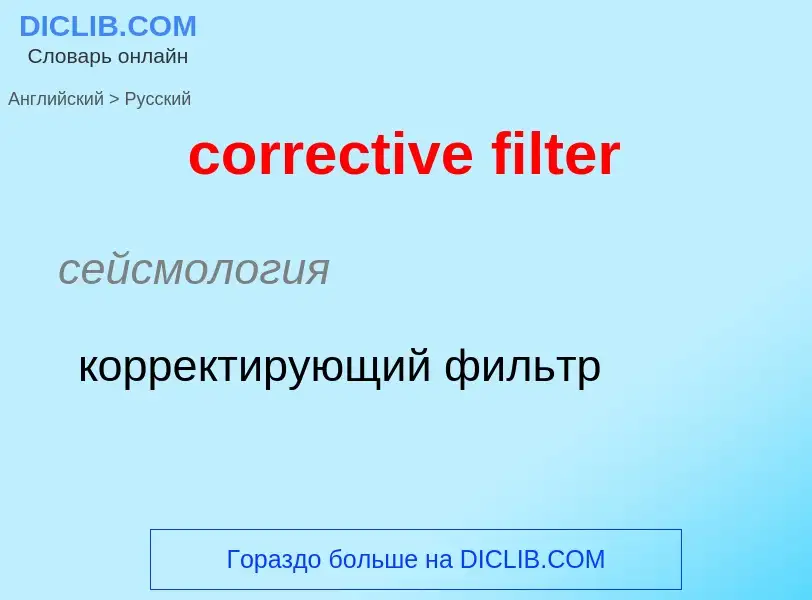Перевод и анализ слов искусственным интеллектом ChatGPT
На этой странице Вы можете получить подробный анализ слова или словосочетания, произведенный с помощью лучшей на сегодняшний день технологии искусственного интеллекта:
- как употребляется слово
- частота употребления
- используется оно чаще в устной или письменной речи
- варианты перевода слова
- примеры употребления (несколько фраз с переводом)
- этимология
corrective filter - перевод на русский
сейсмология
корректирующий фильтр
общая лексика
съемочный светофильтр
Определение
Википедия
Corrective and preventive action (CAPA or simply corrective action) consists of improvements to an organization's processes taken to eliminate causes of non-conformities or other undesirable situations. It is usually a set of actions, laws or regulations required by an organization to take in manufacturing, documentation, procedures, or systems to rectify and eliminate recurring non-conformance. Non-conformance is identified after systematic evaluation and analysis of the root cause of the non-conformance. Non-conformance may be a market complaint or customer complaint or failure of machinery or a quality management system, or misinterpretation of written instructions to carry out work. The corrective and preventive action is designed by a team that includes quality assurance personnel and personnel involved in the actual observation point of non-conformance. It must be systematically implemented and observed for its ability to eliminate further recurrence of such non-conformation. The Eight disciplines problem solving method, or 8D framework, can be used as an effective method of structuring a CAPA.
Corrective action: Action taken to eliminate the causes of non-conformities or other undesirable situations, so as to prevent recurrence.
Preventive action: Action taken to prevent the occurrence of such non-conformities, generally as a result of a risk analysis.
In certain markets and industries, CAPA may be required as part of the quality management system, such as the Medical Devices and Pharmaceutical industries in the United States. In this case, failure to adhere to proper CAPA handling is considered a violation of US Federal regulations on good manufacturing practices. As a consequence, a medicine or medical device can be termed as adulterated or substandard if the company has failed to investigate, record and analyze the root cause of a non-conformance, and failed to design and implement an effective CAPA.
CAPA is used to bring about improvements to an organization's processes, and is often undertaken to eliminate causes of non-conformities or other undesirable situations. CAPA is a concept within good manufacturing practice (GMP), Hazard Analysis and Critical Control Points/Hazard Analysis and Risk-based Preventive Controls (HACCP/HARPC) and numerous ISO business standards. It focuses on the systematic investigation of the root causes of identified problems or identified risks in an attempt to prevent their recurrence (for corrective action) or to prevent occurrence (for preventive action).
Corrective actions are implemented in response to customer complaints, unacceptable levels of product non-conformance, issues identified during an internal audit, as well as adverse or unstable trends in product and process monitoring such as would be identified by statistical process control (SPC). Preventive actions are implemented in response to the identification of potential sources of non-conformity.
To ensure that corrective and preventive actions are effective, the systematic investigation of the root causes of failure is pivotal. CAPA is part of the overall quality management system (QMS).


![The 80A filter, mainly used to correct for the excessive redness of [[tungsten]] lighting, can also be used to oversaturate scenes that already have blue. The photo on the left was shot with a polarizer, while the one on the right was shot with a polarizer and an 80A filter. The 80A filter, mainly used to correct for the excessive redness of [[tungsten]] lighting, can also be used to oversaturate scenes that already have blue. The photo on the left was shot with a polarizer, while the one on the right was shot with a polarizer and an 80A filter.](https://commons.wikimedia.org/wiki/Special:FilePath/80a comparison.jpg?width=200)



![The ''LOMO effect'' imitates photos made with a low-cost Russian camera brand, named "LOMO". It is approximated by saturated central colors, blurred periphery, and darkened corners and edges ([[vignetting]]).}} effect. The ''LOMO effect'' imitates photos made with a low-cost Russian camera brand, named "LOMO". It is approximated by saturated central colors, blurred periphery, and darkened corners and edges ([[vignetting]]).}} effect.](https://commons.wikimedia.org/wiki/Special:FilePath/Verblühende Sauerkirsche.jpg?width=200)
